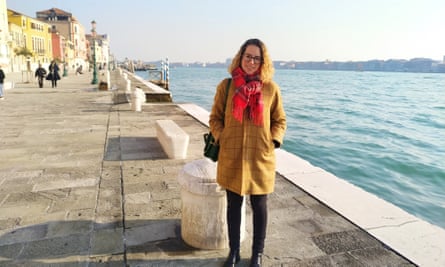[ad_1]
On most mornings, Mylène Ebrard hops on a waterbus from her home in Giudecca, a neighbourhood of Venice with a village-like feel, and across the canal to her favourite bar, where over a hot chocolate she works from her mobile phone. The ritual has become sacred to the rhythm of her day in Venice, where the French communications specialist has lived since October as part of a project aimed at attracting remote workers to help repopulate the lagoon city.
“I was just working on social media for one of my clients. They don’t see the difference if I’m here or in Paris,” said Ebrard, 38. “I love this bar during the day as you get the sun on the terrace. It’s impossible to say it’s ugly in Venice, even when it’s raining.”
In a trend that is showing little sign of abating, the population on Venice’s main island dipped below 50,000 for the first time last summer. Myriad issues have driven more than 120,000 away since the 1950s, although the overriding reason has been the city’s heavy focus on mass tourism, with thousands of visitors crowding its squares, bridges and narrow walkways each day.
Keen to help reverse the decline, a team at Venice’s Ca’ Foscari University and the Fondazione di Venezia, a cultural heritage group, created Venywhere, a project aimed at enticing those who can work from anywhere to move to the city.

“There has been a strong population decline, but the other aspect is the age of those left – there is a big gap in the 25 to 35-year-old demographic,” said Massimo Warglien, a professor at Ca’ Foscari. “The objective is to attract new, qualified citizens to help change the demographic dynamic and skills of the city while at the same time imagining Venice as a laboratory to explore new ways of working.”
Ebrard didn’t need much persuading. Browsing her phone last June, she came across a story about the initiative in a French newspaper. Dealing with a break-up with her husband and sensing the time away could be beneficial, she swiftly applied.
“My grandmother was Italian and it was my dream to move to Italy,” she said. “I started to learn Italian during the coronavirus pandemic and then thought ‘I have nothing and nobody stopping me, so why not’?”
The application process is hardly onerous: you simply need to prove you can work remotely and be willing to live in Venice for at least three months. In return for a small one-off fee, the project team provides services such as assistance with finding an apartment and dealing with visa requirements as well as organising events to help the newcomers integrate.
The scheme attracted hundreds of applicants and since it began last March, it has welcomed dozens of digital nomads, including a group of 16 employees from the technology company Cisco, which is collaborating with Venywhere in its study of hybrid working.
Ebrard is among the 35 from all over the world currently living in Venice and will be there until June. She rents an apartment with a view over the Giudecca canal and has made friends with her Venetian neighbours. “I feel safe here, I can walk everywhere, I can soak up the art and culture, and the people have been very kind,” Ebrard said. “I have more time for people, more time for me and more time to figure out what I want in the future. It is as if life has sprinkled some magic on me.”
Alan Bruton, an American professor of architecture, has been teaching online since moving to the city in the autumn and has had such a good experience that he decided to stay and focus full-time on his new venture: designing a board game inspired by Venice.
“I aim to produce and become a productive member of the city,” said the 59-year-old, who has an Irish passport that enables him to stay in Europe. “It’s the perfect place for me to be located.”
Jonathan Wehlte, a software engineer from Germany, has also decided to stay longer-term. “Venice is very different from any other city I have lived in,” said Wehlte, 35. “There are no cars, you can walk everywhere… and there is so much beauty it inspires you to get out of your habitual thoughts. You start to get new ideas, and think about how society could be in the future.”
after newsletter promotion
Venice has experienced other mass exoduses over its history, such as after the fall of its powerful maritime republic which impoverished the city economically.

“Before the fall of the Republic in 1797 the population was around 150,000 and in 1838 it was almost 40% less,” said Warglien. “It took decades to get back to the original population size and most of the recovery was due to a positive migratory balance.”
Venice has been creative in attracting new inhabitants in the past, he added. “During the Republic there were two levels of citizenship – for Venetians and non-Venetians, who were typically merchants. We need to think about different forms of citizenship.”
Much as they can’t dispute the uniqueness of the city, newcomers acknowledge the challenges experienced by Venetians, such as the struggle to find affordable housing or jobs that are not related to tourism. One specific downside for the digital nomads is the scarcity of co-working space.
Of course, there is the issue of living among hordes of visitors. “The true challenge is not imagining that mass tourism will magically finish – that would be difficult – but creating an alternative,” said Warglien. “We need to create a model that maintains a normal urban life and is not only dependent on tourism.”
[ad_2]
#Life #sprinkled #magic #Venice #entices #remote #workers #reverse #exodus #youth
( With inputs from : www.theguardian.com )